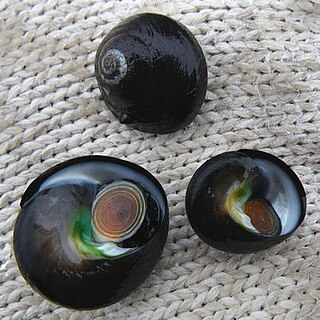
The Noctilucales are an order of marine dinoflagellates. They differ from most others in that the mature cell is diploid and its nucleus does not show a dinokaryotic organization. They show gametic meiosis.

Edward Forbes FRS, FGS was a Manx naturalist. In 1846, he proposed that the distributions of montane plants and animals had been compressed downslope, and some oceanic islands connected to the mainland, during the recent ice age. This mechanism, which was the first natural explanation to explain the distributions of the same species on now-isolated islands and mountain tops, was discovered independently by Charles Darwin, who credited Forbes with the idea. He also incorrectly deduced the so-called azoic hypothesis, that life under the sea would decline to the point that no life forms could exist below a certain depth.

Sphaerites is a genus of beetles, the only genus in the family Sphaeritidae, sometimes called the false clown beetles. There are five known species, which are widespread in temperate areas of the Northern Hemisphere, found in forested or upland areas.

Reinhardtia is a genus in the palm family native to the northern Neotropics. It is a primarily Central American genus with five species distributed between southern Mexico and the extreme north of Colombia, and one isolated species, Reinhardtia paiewonskiana in the southwest of the Dominican Republic.

The rainbow-bearded thornbill is a species of hummingbird in the "coquettes", tribe Lesbiini of subfamily Lesbiinae. It is found in Colombia, Ecuador, and Peru.

Dentalium is a large genus of tooth shells or tusk shells, marine scaphopod molluscs in the family Dentaliidae. The genus contains 50 described species and about 50 extinct species.

Goniodoris is a genus of sea slugs, specifically dorid nudibranchs, marine gastropod molluscs in the family Goniodorididae.

Thesbia is a genus of sea snails, marine gastropod mollusks belonging to the family Raphitomidae.

Mangelia is a large genus of sea snails, marine gastropod mollusks in the family Mangeliidae.

Siphonalia is a genus of sea snails, marine gastropod mollusks in the subfamily Siphonaliinae of the family Buccinidae, the true whelks.

Chlorostoma is a genus of sea snails, marine gastropod mollusks in the family Tegulidae.

The Ditomyiidae are a small family of flies (Diptera).They are found worldwide, most species are found in the Australasian and Neotropical realms. There are only two genera in Europe Ditomyia Winnertz, 1846 and Symmerus Walker, 1848 Ditomyia is found in Central Europe Symmerus in Northern Europe Symmerus is endemic to the Palaearctic.

Calyptraea, commonly known as the Chinese hat snails is a genus of sea snails, marine gastropod mollusks in the family Calyptraeidae, a family which contains the slipper snails or slipper limpets, cup-and-saucer snails, and Chinese hat snails.

Bougainvillia is a genus of hydroids in the family Bougainvilliidae in the class Hydrazoa. Members of the genus are characterised by having the marginal tentacles of their medusae arranged in four bundles. Some species are solitary and others are colonial but all are filter feeders. They are found in the Southern Ocean, having a circumpolar distribution, but some species also occur in the Northern Hemisphere, possibly travelling there as polyps on the hulls of ships.

Eutrephoceras is an extinct genus of nautilus from the Late Jurassic to the Miocene. They are characterized by a highly rounded involute shell with slightly sinuous suture patterns.

Corynidae is a family of hydrozoans in the order Anthomedusae.

Haemopis is a genus of leeches belonging to the family Haemopidae. The species of this genus are found in Eurasia and Northern America.

Brissus is a genus of echinoderms belonging to the family Brissidae.

Turbinolia is a genus of corals belonging to the family Turbinoliidae.



















